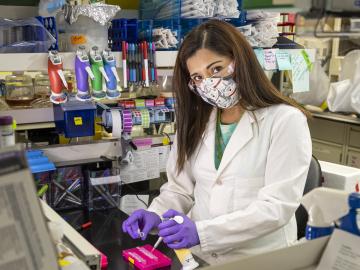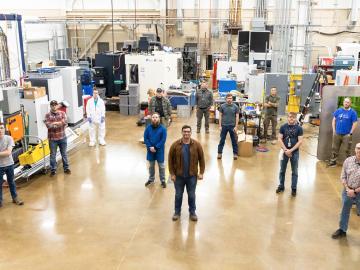
Filter News
Area of Research
- Advanced Manufacturing (2)
- Biology and Environment (93)
- Computational Biology (2)
- Computational Engineering (1)
- Computer Science (2)
- Energy Science (40)
- Fusion and Fission (5)
- Fusion Energy (1)
- Isotope Development and Production (2)
- Isotopes (28)
- Materials (50)
- Materials for Computing (8)
- National Security (33)
- Neutron Science (21)
- Nuclear Science and Technology (9)
- Quantum information Science (4)
- Sensors and Controls (1)
- Supercomputing (71)
News Topics
- (-) Biology (128)
- (-) Cybersecurity (35)
- (-) Hydropower (12)
- (-) Irradiation (3)
- (-) Isotopes (62)
- (-) Microscopy (56)
- (-) Security (31)
- (-) Space Exploration (26)
- (-) Summit (71)
- 3-D Printing/Advanced Manufacturing (146)
- Advanced Reactors (40)
- Artificial Intelligence (131)
- Big Data (79)
- Bioenergy (112)
- Biomedical (73)
- Biotechnology (39)
- Buildings (74)
- Chemical Sciences (86)
- Clean Water (33)
- Composites (35)
- Computer Science (226)
- Coronavirus (48)
- Critical Materials (29)
- Education (5)
- Element Discovery (1)
- Emergency (4)
- Energy Storage (114)
- Environment (218)
- Exascale Computing (67)
- Fossil Energy (8)
- Frontier (64)
- Fusion (66)
- Grid (74)
- High-Performance Computing (130)
- ITER (9)
- Machine Learning (68)
- Materials (157)
- Materials Science (158)
- Mathematics (12)
- Mercury (12)
- Microelectronics (4)
- Molten Salt (10)
- Nanotechnology (64)
- National Security (86)
- Neutron Science (171)
- Nuclear Energy (122)
- Partnerships (68)
- Physics (69)
- Polymers (35)
- Quantum Computing (53)
- Quantum Science (93)
- Simulation (65)
- Software (1)
- Statistics (4)
- Transportation (103)
Media Contacts


From soda bottles to car bumpers to piping, electronics, and packaging, plastics have become a ubiquitous part of our lives.

The University of Texas at San Antonio (UTSA) has formally launched the Cybersecurity Manufacturing Innovation Institute (CyManII), a $111 million public-private partnership.

The annual Director's Awards recognized four individuals and teams including awards for leadership in quantum simulation development and application on high-performance computing platforms, and revolutionary advancements in the area of microbial

ORNL has added 10 virtual tours to its campus map, each with multiple views to show floor plans, rotating dollhouse views and 360-degree navigation. As a user travels through a map, pop-out informational windows deliver facts, videos, graphics and links to other related content.

There are more than 17 million veterans in the United States, and approximately half rely on the Department of Veterans Affairs for their healthcare.

The life of celebrated ORNL biologist Liane Russell was remarkable in many respects — from her childhood flight from Austria ahead of the Nazi invasion to her 60-year career as a trailblazing woman in the field of genetics to her decades of advocacy for environmental causes.

Scientists at ORNL and the University of Nebraska have developed an easier way to generate electrons for nanoscale imaging and sensing, providing a useful new tool for material science, bioimaging and fundamental quantum research.

Radioactive isotopes power some of NASA’s best-known spacecraft. But predicting how radiation emitted from these isotopes might affect nearby materials is tricky

Researchers at ORNL used quantum optics to advance state-of-the-art microscopy and illuminate a path to detecting material properties with greater sensitivity than is possible with traditional tools.


